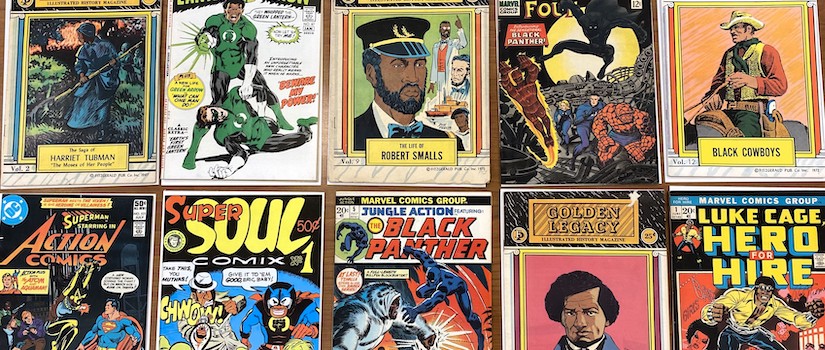USC’s Watson Collection Reveals Rich History of African Americans in Comics
Six years ago, on February 16, 2018, Marvel’s Black Panther exploded onto the screen, and smashed records, becoming both the first standalone superhero movie featuring a Black main character and one of the highest grossing Marvel films to date. But while Chadwick Boseman’s King T’Challa was the first to stand alone on the silver screen, African American representation in comic books has a long and complex history – one that USC’s Gary Lee Watson Comic Book Collection reveals in rich detail.
University Libraries acquired the collection from Mr. Watson, a lifelong comics collector, in the spring of 2019. At the time of its acquisition, the collection promised to be an invaluable asset to the university's research prospects, as it is one of the largest of its kind in the country.
Dr. Qiana Whitted is one of several USC faculty members whose work draws on the Watson Collection. Originally hired to teach African American literature and cultural studies in 2003, Whitted quickly realized that she could bring a passion she held in her free time into the fold of the research she was already pursuing. That passion? Comic books.
“I realized that many of the questions that I was asking about African American literary production could also be asked of the comic books and graphic novels that I have enjoyed since I was a teenager,” Whitted says.
Though the best-selling comic books during the mid-twentieth century weren’t often “dealing with race in an explicit way,” she says, there was still a lot happening within the medium to put these questions forward. African American representation in comic books has evolved over time, but the issue of this representation has been present since comic books’ inception in the 1930’s. Black characters appeared in all different types of comics, starting in the late 1930s, including those focused on crime, horror, science fiction, westerns and romance. Nevertheless, Black Panther remains one of the first and most notable superhero characters today.
The King of Wakanda made his first appearance in the Fantastic Four #52, which was published in July of 1966 by Marvel comics. Even though Black Panther was widely known as the starting point for mainstream Black superhero representation in comic books, Whitted realized there was a much longer history to this topic than she realized.
“I realized going to archives and looking at some of the comics, like the ones we have in our collection, that there is actually a much longer history and that comics have been representing race in both really problematic ways and productive ways since.”
A lot of the work that Whitted does, especially in her recent publication, deals with comics that had a big impact on readers, even though they may not have been the most popular or profitable titles at the time.
“Having such an extensive collection allows you to see what was popular, but it also allows you to see the experiments, and the publishers’ efforts to try a new way of storytelling. Even in the flops and the failures, you see efforts to do something more,” Whitted says.
Another valuable piece of the archive that many people may not consider is the correspondence associated with the comic books, which provides valuable information on what was circulating between writers and creators at the time. Whitted especially remembers going through part of the collection containing the series ICON, a comic book series produced by Milestone Comics. Milestone was an African American-owned comic book imprint distributed by DC in the 1990s. Whitted remembers seeing letters to and from people who were reading the series at the time, for the first time. Being able to physically see that dialog and exchange was a new and fascinating experience for Whitted.
Among the superheroes and epic tales, can be found several biographical comics about African American figures. Fairly well-known publications, like Martin Luther King and the Montgomery Story (1957), can be found alongside Golden Legacy publications like Black Cowboys. Golden Legacy has also made a comic about the famous South Carolina-born Civil War hero and politician Robert Smalls, which can also be found in the collection.
However, even with the great diversity and accessibility that the collection provides there’s one other more tangible aspect of having the original comic books that Whitted finds valuable. “With the reprints, you don’t get to see some of the way the paper used to look and the coloring,” said Whitted. Through the collection’s vast holdings of original older comics, researchers can see the gradual change in the color printing and quality over time.
“American comics are American culture,” Whitted said. Comic books allow for a corollary study into American culture from every angle, and this can be especially seen in a collection like the Gary Lee Watson Comic Book Collection at USC. With a collection so vast and expansive, researchers can get glimpses into not only the history of the comic book, but an ephemeral history of the country at large.
Check out the Black History Month exhibit at the front of Thomas Cooper Library to see some of these historic comics in person.
